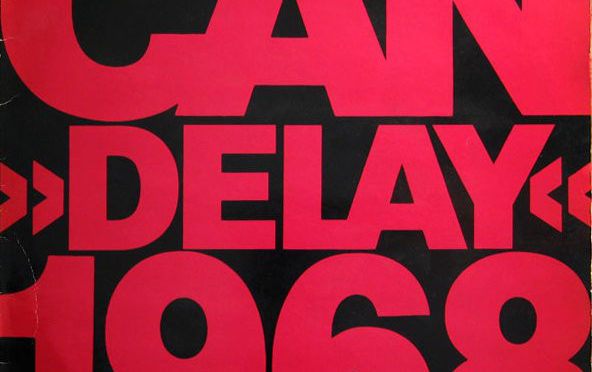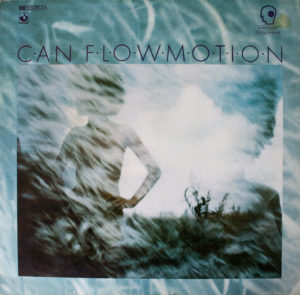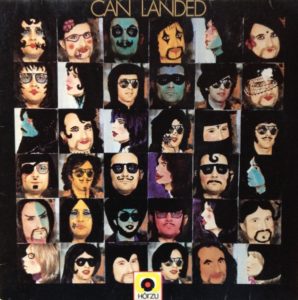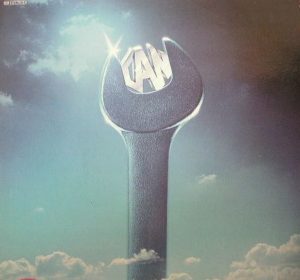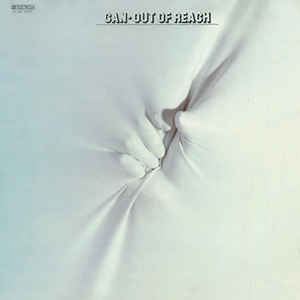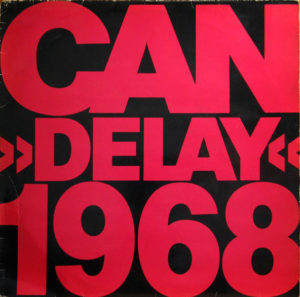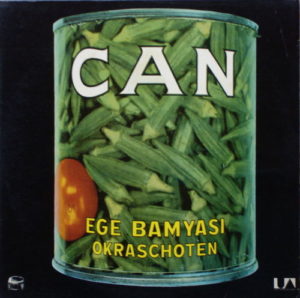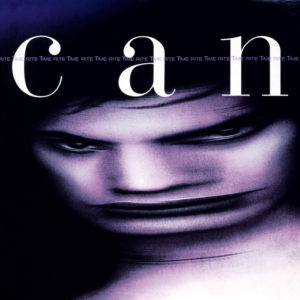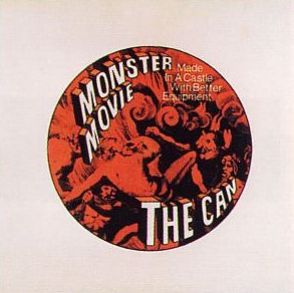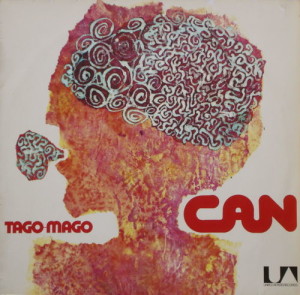This is a guide to the music of CAN. Releases are divided into full albums, miscellany (mostly archival, soundtrack, and outtake collections), and non-album singles, with each section arranged chronologically by recording date. Other resources — books, films, a soundtrack filmography, and web sites — are listed at the end.
A Brief Introduction:
CAN was formed in the late 1960s in Köln (Cologne), in what was then West Germany. The band approached rock and pop music with sort of an outsider’s perspective, very much the way pianist/composer Cecil Taylor approached jazz in a unique way from the standpoint of formal training in modern classical music. There was a tacit affinity in their worldview to the so-called “New Left” movement of the late 1960s. The band is also cited as a pillar of the “krautrock” movement that sought to reconstruct a new German cultural identity following the defeat of the Nazis by the Soviet Union and allied powers — most of the band members grew up knowing former Nazis. They did not want to sound like other pop music. The band’s music draws influence and comparisons to electronic “new music” composers like Karlheinz Stockhausen and the chance music of John Cage, rock bands like The Velvet Underground, Captain Beefheart & His Magic Band, The Jimi Hendrix Experience and Sly & The Family Stone, the vamping funk rock of James Brown, and dub reggae from the likes of producer Lee “Scratch” Perry. While band members had great familiarity with jazz, they either couldn’t or didn’t want to play jazz. They did not work with outside producers or even record in commercial recording studios, instead forging their own path in a do-it-yourself way in which they maintained control over all aspects of their recordings. Always something of a cult phenomenon, CAN remained critical darlings. Curiously, or maybe not so much, the band’s audience has primarily been male. Anyway, even nearly a half-century later the band’s music sounds stunningly fresh and impressive.
Original members Irmin Schmidt, Holger Czukay and David Johnson came from backgrounds in modern classical music, each having studied at Darmstadt with Karlheinz Stockhausen. Drummer Jaki Liebezeit came from a background in jazz, departing a position in Manfred Schoof‘s band after deciding that the scrupulous avoidance of a rhythmic pulse in free jazz was too constraining. Guitarist Michael Karoli was a former student of Czukay’s who gave up studying law to be a musician instead. Schmidt was a working conductor and composer who visited New York City where he was introduced to underground rock and the pop art scene. He returned to West Germany inspired, and with Czukay committed to starting a rock band. Johnson soon departed as the band pursued more of a focus on rock than pure avant-garde electronics. Malcolm Mooney was an American traveling the world under the alias Desse Barama to try to avoid being drafted into the military during the Vietnam War, and ended up connecting with CAN partly out of confusion — he wanted to find a visual artist’s studio but ended up in a musical studio. Although not intending to be a singer when he arrived in Germany, and having no real experience as such, Mooney helped the band coalesce its unique syncretic approach to music with a strong sense of rhythm. Anxiety about returning to America and being drafted eventually necessitated Mooney’s departure. He was soon after replaced by “Damo” Suzuki. An anarchist by disposition, Damo had left home dissatisfied with Japanese culture through a connection with a pen pal in Sweden. He had made his way to Germany where he frequently busked on the streets of Cologne and also was involved in a theater orchestra/band. Holger Czukay encountered him on the street and invited him to sign at a concert that evening, with no rehearsal.
Most band members came from a middle-class backgrounds (in one case more upper class). This gave them access to unique opportunities and allowed them to overcome obstacles that would have caused the demise of other bands. For instance, Damo was very nearly deported before Irmin’s connections to West German state radio lead to a high-level government intervention that allowed Damo to remain. Another sometimes overlooked aspect of the band’s history is that they formed in the wake of the so-called West German “Economic Miracle,” which partly stemmed from the Marshall Plan but was primarily a function of the USA forgiving WWII debts and using West Germany (and Japan, and later South Korea) as special economic development zones — something explicitly and purposefully denied to the UK and France. In that climate of economic abundance there were funds and materials floating around for artistic projects. The band maintained a very collective approach to music-making. Everyone’s contributions were considered at an equal level. There was no band hierarchy or designated leader. Compositions, production and similar efforts were credited to the entire band regardless of specific individual contributions. They also exactly equally shared band income, at least once Hildegard Schmidt became manager.
Achieving modest popularity in West Germany and the United Kingdom, they had some minor commercial success with recordings but had only one regional “hit” song with “I Want More.” As the 70s rolled on, new members Rosko Gee and Reebop Kwaku Baah (both formerly of Traffic) joined in. Czukay left the band by the end of 1977.
The band formally split up in 1979. Irmin Schmidt then founded Spoon Records, and, via a distribution arrangement with Mute Records, CAN recordings are now more available than ever. A few archival releases dribbled out in the early 80s, as well as some compilations. A reunion instigated by originally vocalist Malcolm Mooney happened in the late 80s that lead to a new album. A few additional reunion recordings of individual songs and sporadic reunion concerts took place too. The former band members mostly pursued solo and other new musicals projects, and often collaborated.

